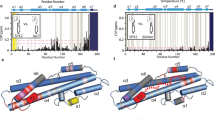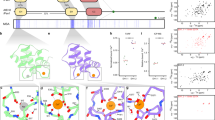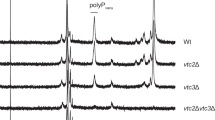Abstract
Specific recognition of phosphoinositides is crucial for protein sorting and membrane trafficking. Protein transport to the yeast vacuole depends on the Vam7 t-SNARE and its phox homology (PX) domain. Here, we show that the PX domain of Vam7 targets to vacuoles in vivo in a manner dependent on phosphatidylinositol 3-phosphate generation. A novel phosphatidylinositol-3-phosphate-binding motif and an exposed loop that interacts with the lipid bilayer are identified by nuclear magnetic resonance spectroscopy. Conservation of key structural and binding site residues across the diverse PX family indicates a shared fold and phosphoinositide recognition function.
This is a preview of subscription content, access via your institution
Access options
Subscribe to this journal
Receive 12 print issues and online access
$209.00 per year
only $17.42 per issue
Buy this article
- Purchase on Springer Link
- Instant access to full article PDF
Prices may be subject to local taxes which are calculated during checkout





Similar content being viewed by others
References
Ponting, C. P. Novel domains in NADPH oxidase subunits, sorting nexins, and PtdIns 3-kinases: binding partners of SH3 domains? Protein Sci. 5, 2353–2357 (1996).
Noack, D. et al. Autosomal recessive chronic granulomatous disease caused by defects in NCF-1, the gene encoding the phagocyte p47-phox: mutations not arising in the NCF-1 pseudogenes. Blood 97, 305–311 (2001).
Sato, T. K., Darsow, T. & Emr, S. D. Vam7p, a SNAP-25-like molecule, and Vam3p, a syntaxin homolog, function together in yeast vacuolar protein trafficking. Mol. Cell Biol. 18, 5308–5319 (1998).
Schu, P. V. et al. Phosphatidylinositol 3-kinase encoded by yeast VPS34 gene essential for protein sorting. Science 260, 88–91 (1993).
Gary, J. D., Wurmser, A. E., Bonangelino, C. J., Weisman, L. S. & Emr, S. D. Fab1p is essential for PtdIns(3)P 5-kinase activity and the maintenance of vacuolar size and membrane homeostasis. J. Cell Biol. 143, 65–79 (1998).
Cooke, F. T. et al. The stress-activated phosphatidylinositol 3-phosphate 5-kinase Fab1p is essential for vacuole function in S. cerevisiae. Curr. Biol. 8, 1219–1222 (1998).
Stack, J. H., DeWald, D. B., Takegawa, K. & Emr, S. D. Vesicle-mediated protein transport: regulatory interactions between the Vps15 protein kinase and the Vps34 PtdIns 3-kinase essential for protein sorting to the vacuole in yeast. J. Cell Biol. 129, 321–334 (1995).
Weimbs, T. et al. A conserved domain is present in different families of vesicular fusion proteins: a new superfamily. Proc. Natl Acad. Sci. USA 94, 3046–3051 (1997).
Fasshauer, D., Eliason, W. K., Brunger, A. T. & Jahn, R. Identification of a minimal core of the synaptic SNARE complex sufficient for reversible assembly and disassembly. Biochemistry 37, 10354–10362 (1998).
Sutton, R. B., Fasshauer, D., Jahn, R. & Brunger, A. T. Crystal structure of a SNARE complex involved in synaptic exocytosis at 2.4 Å resolution. Nature 395, 347–353 (1998).
Babst, M., Sato, T. K., Banta, L. M. & Emr, S. D. Endosomal transport function in yeast requires a novel AAA-type ATPase, Vps4p. EMBO J. 16, 1820–1831 (1997).
Burd, C. G. & Emr, S. D. Phosphatidylinositol(3)-phosphate signaling mediated by specific binding to RING FYVE domains. Mol. Cell 2, 157–162 (1998).
Gaullier, J. M. et al. FYVE fingers bind PtdIns(3)P. Nature 394, 432–433 (1998).
Patki, V., Lawe, D. C., Corvera, S., Virbasius, J. V. & Chawla, A. A functional PtdIns(3)P-binding motif. Nature 394, 433–434 (1998).
Gillooly, D. J. et al. Localization of phosphatidylinositol 3-phosphate in yeast and mammalian cells. EMBO J. 19, 4577–4588 (2000).
Dowler, S., Currie, R. A., Downes, C. P. & Alessi, D. R. DAPP1: a dual adaptor for phosphotyrosine and 3-phosphoinositides. Biochem. J. 342, 7–12 (1999).
Kutateladze, T. G. et al. Phosphatidylinositol 3-phosphate recognition by the FYVE domain. Mol. Cell 3, 805–811 (1999).
Gaullier, J. M., Ronning, E., Gillooly, D. J. & Stenmark, H. Interaction of the EEA1 FYVE finger with phosphatidylinositol 3-phosphate and early endosomes. Role of conserved residues. J. Biol. Chem. 275, 24595–24600 (2000).
Phillips, S. A., Barr, V. A., Haft, D. H., Taylor, S. I. & Renfrew, C. Identification and characterization of SNX15, a novel sorting nexin involved in protein trafficking. J. Biol. Chem. 276, 5074–5084 (2001).
Kurten, R. C. et al. Self-assembly and binding of a sorting nexin to sorting endosomes. J. Cell. Sci. 114, 1743–1756 (2001).
Liu, D., Yang, X. & Songyang, Z. Identification of CISK, a new member of the SGK kinase family that promotes IL-3-dependent survival. Curr. Biol. 10, 1233–1236 (2000).
Domin, J., Gaidarov, I., Smith, M. E., Keen, J. H. & Waterfield, M. D. The class II phosphoinositide 3-kinase PI3K-C2α is concentrated in the trans-Golgi network and present in clathrin-coated vesicles. J. Biol. Chem. 275, 11943–11950 (2000).
Yokozeki, T., Kuribara, H., Katada, T., Touhara, K. & Kanaho, Y. Partially purified RhoA-stimulated phospholipase D activity specifically binds to phosphatidylinositol 4,5-bisphosphate. J. Neurochem. 66, 1234–1239 (1996).
Hoer, A., Cetindag, C. & Oberdisse, E. Influence of phosphatidylinositol 4,5-bisphosphate on human phospholipase D1 wild-type and deletion mutants: is there evidence for an interaction of phosphatidylinositol 4,5-bisphosphate with the putative pleckstrin homology domain? Biochim. Biophys. Acta 1481, 189–201 (2000).
Hodgkin, M. N. et al. Phospholipase D regulation and localisation is dependent upon a phosphatidylinositol 4,5-bisphosphate-specific PH domain. Curr. Biol. 10, 43–46 (2000).
Kim, Y. et al. Phosphorylation and activation of phospholipase D1 by protein kinase C in vivo: determination of multiple phosphorylation sites. Biochemistry 38, 10344–10351 (1999).
Kutateladze, T. & Overduin, M. Structural mechanism of endosome docking by the FYVE domain. Science 291, 1793–1796 (2001).
Harlan, J. E., Hajduk, P. J., Yoon, H. S. & Fesik, S. W. Pleckstrin homology domains bind to phosphatidylinositol-4,5-bisphosphate. Nature 371, 168–170 (1994).
Ferguson, K. M. et al. Structural basis for discrimination of 3-phosphoinositides by pleckstrin homology domains. Mol. Cell 6, 373–384 (2000).
Sutton, R. B., Ernst, J. A. & Brunger, A. T. Crystal structure of the cytosolic C2A–C2B domains of synaptotagmin III. Implications for Ca2+-independent snare complex interaction. J. Cell. Biol. 147, 589–598 (1999).
Itoh, T. et al. Role of the ENTH domain in phosphatidylinositol-4,5-bisphosphate binding and endocytosis. Science 291, 1047–1051 (2001).
Ford, M. G. et al. Simultaneous binding of PtdIns(4,5)P2 and clathrin by AP180 in the nucleation of clathrin lattices on membranes. Science 291, 1051–1055 (2001).
Kay, L. E. Pulsed field gradient multi-dimensional NMR methods for the study of protein structure and dynamics in solution. Prog. Biophys. Mol. Biol. 63, 277–299 (1995).
Wishart, D. S. & Sykes, B. D. The 13C chemical-shift index: a simple method for the identification of protein secondary structure using 13C chemical-shift data. J. Biomol. NMR 4, 171–180 (1994).
Vuister, G. W. & Bax, A. Quantitative J correlation – a new approach for measuring homonuclear 3-bond JHNHα coupling constants in 15N enriched proteins. J. Am. Chem. Soc. 115, 7772–7777 (1993).
Delaglio, F. et al. NMRPipe: a multidimensional spectral processing system based on UNIX pipes. J. Biomol. NMR 6, 277–293 (1995).
Lukin, J. A., Gove, A. P., Talukdar, S. N. & Ho, C. Automated probabilistic method for assigning backbone resonances of (13C,15N)-labeled proteins. J. Biomol. NMR 9, 151–166 (1997).
Cowles, C. R., Odorizzi, G., Payne, G. S. & Emr, S. D. The AP-3 adaptor complex is essential for cargo-selective transport to the yeast vacuole. Cell 91, 109–118 (1997).
Grzesiek, S. et al. The solution structure of HIV-1 Nef reveals an unexpected fold and permits delineation of the binding surface for the SH3 domain of Hck tyrosine protein kinase. Nature Struct. Biol. 3, 340–345 (1996).
Acknowledgements
We thank D. G. S. Capelluto, J. L. Enmon, D. N. M. Jones and A. E. Wurmser for discussions and L. E. Kay for pulse sequences. We also thank C. Sette, P. Iaquinta, J. Thorner, X. Song, W. Xu, A. Zhang, G. Huang, X. Liang, J. V. Virbasius, M. P. Czech and G. W. Zhou for sharing unpublished data. We are supported by the Pew Scholars Program, University of Colorado Cancer Center and University of Colorado Health Sciences Center NMR Facility.
Author information
Authors and Affiliations
Corresponding author
Rights and permissions
About this article
Cite this article
Cheever, M., Sato, T., de Beer, T. et al. Phox domain interaction with PtdIns(3)P targets the Vam7 t-SNARE to vacuole membranes. Nat Cell Biol 3, 613–618 (2001). https://doi.org/10.1038/35083000
Received:
Revised:
Accepted:
Published:
Issue Date:
DOI: https://doi.org/10.1038/35083000
This article is cited by
-
Lysine acetylation regulates the interaction between proteins and membranes
Nature Communications (2021)
-
PI3K/Akt pathway is involved in the activation of RAW 264.7 cells induced by hydroxypropyltrimethyl ammonium chloride chitosan
Journal of Oceanology and Limnology (2020)
-
Classification of the human phox homology (PX) domains based on their phosphoinositide binding specificities
Nature Communications (2019)
-
The inner workings of intracellular heterotypic and homotypic membrane fusion mechanisms
Journal of Biosciences (2019)
-
Sorting nexin-4 regulates β-amyloid production by modulating β-site-activating cleavage enzyme-1
Alzheimer's Research & Therapy (2017)



